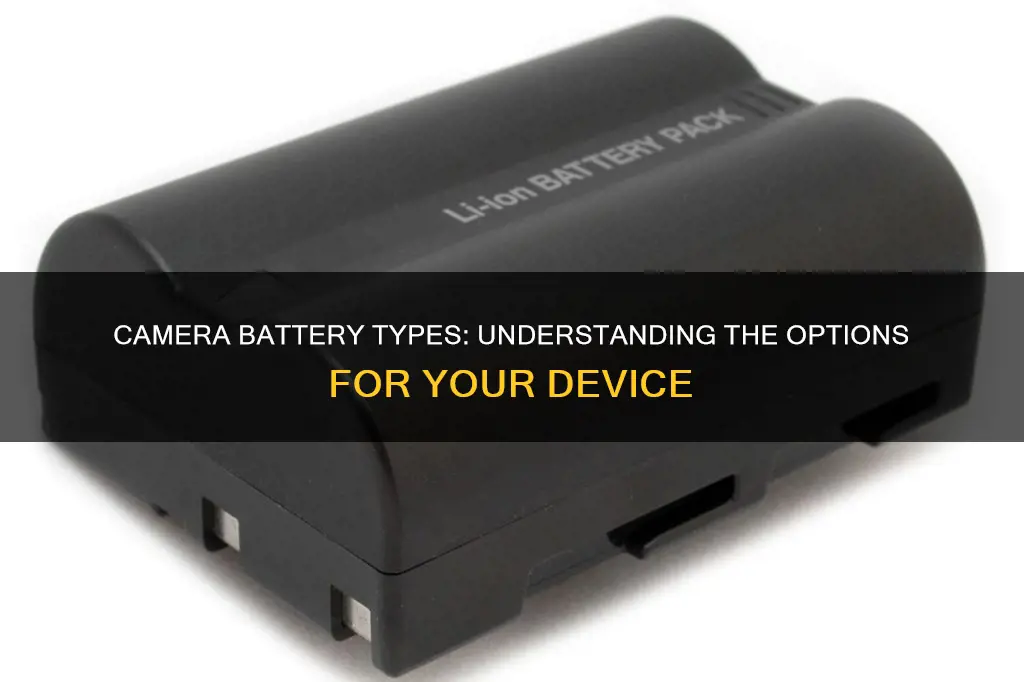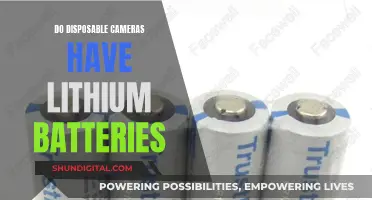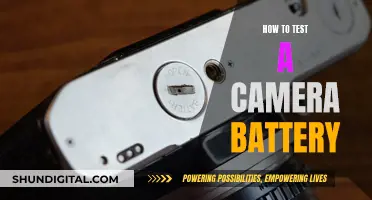
There are several types of batteries used in cameras, and the right choice depends on the type of camera and your budget. Most modern digital cameras use rechargeable lithium-ion batteries, which are lightweight, powerful, and environmentally friendly. However, some cameras still use disposable batteries like AA or AAA batteries, which are affordable and convenient in emergencies but less powerful and more wasteful. Other options include nickel-metal-hydride (NiMH) and lithium-polymer (Li-Pol) batteries, which have their own advantages and disadvantages.
| Characteristics | Values |
|---|---|
| Battery Type | Alkaline, Lithium, Rechargeable, Salt-Based, Nickel-Cadmium, Nickel Metal Hydride, Lithium-Ion, Lithium-Polymer, Disposable |
| Battery Shape | AA, AAA, Battery Packs |
| Battery Life | Varies, Lithium-Ion lasts longer |
| Battery Cost | Varies, Disposable is cheaper |
| Battery Weight | Varies, Nickel-Metal Hydride is heavier |
| Battery Temperature Resistance | Varies, Lithium handles cold better |
| Battery Usage | Varies, Disposable batteries are for emergencies |
What You'll Learn

Rechargeable vs. disposable batteries
When it comes to choosing between rechargeable and disposable batteries for your camera, there are several factors to consider. While most modern digital cameras have shifted towards using rechargeable batteries, disposable batteries still remain relevant and offer certain advantages.
Disposable batteries are typically alkaline batteries, which produce energy through irreversible chemical reactions. Once they are discharged, they need to be discarded as recharging them is impossible. Disposable batteries are inexpensive and readily available, making them a convenient option when you need a quick power source. They are suitable for devices with low power requirements, such as flashlights, remote controls, and calculators. However, they are not ideal for high-power devices like cameras, as they cannot provide sufficient power for lengthy shooting or high image quality.
On the other hand, rechargeable batteries offer a more sustainable and cost-effective solution in the long run. These batteries utilize reversible chemical reactions, allowing them to be recharged multiple times. Rechargeable batteries are particularly useful for photographers who need a reliable power source during outdoor shoots, eliminating the need to constantly replace disposable batteries. They are also environmentally friendly and budget-friendly, as you don't need to keep purchasing new batteries.
Rechargeable batteries, such as lithium-ion (Li-ion) and nickel-metal hydride (NiMH) batteries, are commonly used in modern digital cameras. Li-ion batteries are known for their high discharge voltage, energy density, and compatibility with various devices. NiMH batteries, on the other hand, have a slower discharge rate and higher total charge capacity compared to other rechargeable options.
While rechargeable batteries offer long-term benefits, they come with a higher upfront cost. Additionally, rechargeable batteries require proper care and maintenance to ensure optimal performance and longevity. It is important to use the correct battery charger, avoid overcharging or completely draining the battery, and store them at room temperature to prevent damage.
In summary, the choice between rechargeable and disposable batteries depends on your specific needs, budget, and values. Disposable batteries are ideal for occasional use or as backup options, while rechargeable batteries are better suited for frequent or long-term use, providing a more sustainable and cost-effective solution.
Point-and-Click Camera Batteries: Are They Lithium-Based?
You may want to see also

Lithium-ion batteries
Li-ion batteries have a high discharge voltage and significant energy consumption, and they can be recharged many times, typically from 500 to 3000 cycles. This makes them a long-lasting and cost-effective choice for photographers. Additionally, their low self-discharge rate means they can hold a charge for extended periods when not in use.
Another advantage of Li-ion batteries is their ability to operate over a wide range of temperatures and discharge currents. This versatility ensures they can be used in various conditions and environments. Furthermore, some camera manufacturers stick to a specific lithium-ion battery design for multiple generations of cameras, allowing photographers to continue using their existing batteries when upgrading their equipment.
To maximise the lifespan of Li-ion batteries, it is recommended to follow best practices such as using the correct battery charger, avoiding overcharging or fully draining the battery, and storing the batteries at room temperature.
Charging Camera Batteries: How Long is Too Long?
You may want to see also

Nickel-metal-hydride batteries
NiMH batteries have a high energy density, allowing them to store two to three times more energy than traditional batteries of the same size. This makes them ideal for high-performance electronics and high-drain devices, such as digital cameras, where they can provide longer battery life. They are also widely used in mobile phones, laptops, tablets, camcorders, and handheld game consoles.
One of the advantages of NiMH batteries is their long cycle life, with some sources stating they can last up to 3000 cycles. They are also capable of tolerating overcharge and over-discharge conditions, which simplifies maintenance. Additionally, NiMH batteries are available in various standard sizes, including AA, AAA, C, D, and 9V, making them compatible with a wide range of devices.
However, one drawback of NiMH batteries is their higher self-discharge rate compared to other types of batteries. This means that they can lose up to 5% of their charge per day. They are also more susceptible to heat generation during charging, especially when a full charge is reached. Despite these limitations, NiMH batteries remain a popular choice for photographers due to their high energy density and compatibility with digital cameras.
Camera Batteries: Do They Die?
You may want to see also

Battery maintenance
Camera batteries require maintenance to ensure they hold a charge and perform optimally. Here are some tips for maintaining your camera batteries:
Charging and Discharging
Frequent charging is essential to maintaining your camera battery's performance. Charge your battery regularly, even if it's not fully discharged, as this will help preserve its full capacity. Recharge your battery at a partial discharge rather than waiting for a full discharge. However, avoid overcharging your battery, as this can also cause stress and reduce its lifespan. Additionally, it is recommended to discharge your battery frequently, especially if you won't be using your camera for an extended period.
Storage
Store your batteries in a cool, dry place, away from direct sunlight or other heat sources. Prolonged exposure to heat can cause a rapid loss of battery capacity. If you plan to store your camera for a while without use, remove the batteries and store them separately in a safe place. This will help prevent battery corrosion, which commonly occurs when a battery is left in a device for too long.
Temperature
Avoid exposing your camera battery to extreme temperatures, whether hot or cold. Both high and low temperatures can damage rechargeable batteries and affect their performance. Store your batteries at room temperature whenever possible. If you must use your camera in cold conditions, keep the battery close to your body to benefit from your body heat, helping it maintain its charge.
Battery Care
Keep the metal contacts of your battery clean and free from corrosion. Check for any signs of corrosion, especially if the battery has been stored in the camera for a long time or in a humid environment. Remove any corrosion buildup, as it can interfere with the battery's ability to charge properly. Additionally, ensure that the battery's metal contacts and the contacts inside the battery compartment are free from scratches or smudges, as these can hinder proper connection and impact battery performance.
Power-Saving Measures
To conserve battery power, utilise the viewfinder on your camera instead of the LCD screen, as the latter consumes more power. If you must use the LCD, reduce its brightness to save power. Avoid excessive scrolling through photos or menu options, as this can also drain the battery. Utilise the power-saving or standby mode on your camera to conserve battery life when not in use.
Extras
Always carry spare batteries with you to ensure you have enough power for your projects. Additionally, consider investing in a dually charger to charge two batteries simultaneously, or use a USB-C cord if your battery supports this option.
Charging Your Canon 80D: A Quick Guide
You may want to see also

Battery packs
Camera battery packs are essential for photographers who want to stay powered up on the go. Most digital cameras contain rechargeable batteries, and it's important to have a few spares on hand to ensure you don't run out of power halfway through a shoot.
When it comes to camera battery packs, there are a few things to keep in mind. Firstly, compatibility is key. Each DSLR, point-and-shoot, and mirrorless camera requires a specific shape and style of battery, so make sure to check that the battery pack you're considering is compatible with your camera.
Another thing to consider is the type of battery. The most common types of rechargeable batteries for cameras are lithium-ion (Li-ion) and nickel-metal hydride (NiMH). Li-ion batteries are usually more powerful and lightweight, while NiMH batteries are more affordable and have a higher energy density. It's also worth noting that Li-ion batteries are more susceptible to temperature extremes, so if you're shooting in cold conditions, you may want to opt for a NiMH battery pack.
Additionally, it's important to properly care for your camera battery packs to ensure they last as long as possible. Be sure to only use the battery charger that came with your camera or battery kit, as off-brand chargers may not be optimised for your batteries. Avoid overcharging or fully draining the batteries, and try to store them at room temperature to avoid permanent damage.
Finally, when purchasing a camera battery pack, it's worth considering the brand. While you can save money by opting for a third-party battery, it's important to check the battery specifications to ensure it will fit your camera and meet its power requirements.
Some popular options for camera battery packs include the Canon LP-E6NH and LP-E17, the Sony NP-FZ100, and the FirstPower 2-Pack LP-E17 Battery Pack. Ultimately, the best camera battery pack for you will depend on your specific camera model and your power needs.
Camera Batteries: Carry-on Essentials for Air Travel
You may want to see also
Frequently asked questions
Camera batteries can be divided into two broad categories: disposable and rechargeable. Disposable batteries produce energy through chemical reactions and cannot be recharged, while rechargeable batteries store energy and can be recharged multiple times.
Common types of disposable batteries include lithium, alkaline, and nickel-metal hydride. Alkaline batteries, such as traditional AA or AAA batteries, are often used in low-power devices but are not ideal for high-power devices like cameras.
Rechargeable camera batteries include lithium-ion (Li-ion) and nickel-metal hydride (NiMH) batteries. Li-ion batteries are commonly used in modern digital cameras as they are lightweight, have a high energy capacity, and can be recharged many times.
Some cameras can be fitted with an add-on battery pack that holds additional batteries, extending the battery life of the camera.
When choosing a camera battery, it's important to consider the specific type required by your camera model. Most modern digital and DSLR cameras use rechargeable Li-ion batteries due to their long-lasting power capabilities. Film cameras, on the other hand, typically require less power and use smaller battery units.







